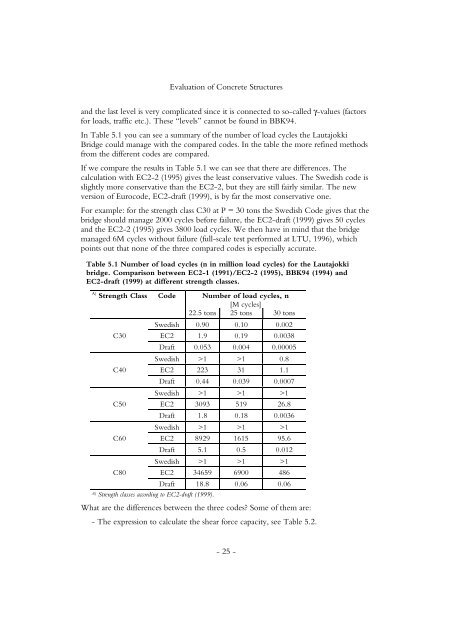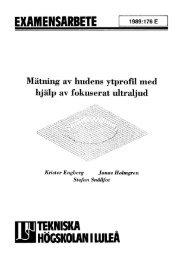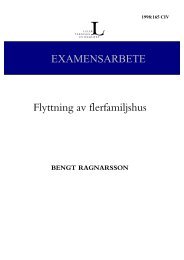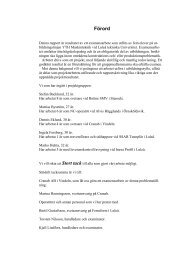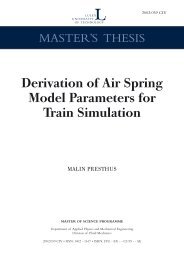LICENTIATE THESIS - Luleå tekniska universitet
LICENTIATE THESIS - Luleå tekniska universitet
LICENTIATE THESIS - Luleå tekniska universitet
You also want an ePaper? Increase the reach of your titles
YUMPU automatically turns print PDFs into web optimized ePapers that Google loves.
Evaluation of Concrete Structures<br />
and the last level is very complicated since it is connected to so-called γ-values (factors<br />
for loads, traffic etc.). These “levels” cannot be found in BBK94.<br />
In Table 5.1 you can see a summary of the number of load cycles the Lautajokki<br />
Bridge could manage with the compared codes. In the table the more refined methods<br />
from the different codes are compared.<br />
If we compare the results in Table 5.1 we can see that there are differences. The<br />
calculation with EC2-2 (1995) gives the least conservative values. The Swedish code is<br />
slightly more conservative than the EC2-2, but they are still fairly similar. The new<br />
version of Eurocode, EC2-draft (1999), is by far the most conservative one.<br />
For example: for the strength class C30 at P = 30 tons the Swedish Code gives that the<br />
bridge should manage 2000 cycles before failure, the EC2-draft (1999) gives 50 cycles<br />
and the EC2-2 (1995) gives 3800 load cycles. We then have in mind that the bridge<br />
managed 6M cycles without failure (full-scale test performed at LTU, 1996), which<br />
points out that none of the three compared codes is especially accurate.<br />
Table 5.1 Number of load cycles (n in million load cycles) for the Lautajokki<br />
bridge. Comparison between EC2-1 (1991)/EC2-2 (1995), BBK94 (1994) and<br />
EC2-draft (1999) at different strength classes.<br />
A) Strength Class Code Number of load cycles, n<br />
[M cycles]<br />
22.5 tons 25 tons 30 tons<br />
Swedish 0.90 0.10 0.002<br />
C30 EC2 1.9 0.19 0.0038<br />
Draft 0.053 0.004 0.00005<br />
Swedish >1 >1 0.8<br />
C40 EC2 223 31 1.1<br />
Draft 0.44 0.039 0.0007<br />
Swedish >1 >1 >1<br />
C50 EC2 3093 519 26.8<br />
Draft 1.8 0.18 0.0036<br />
Swedish >1 >1 >1<br />
C60 EC2 8929 1615 95.6<br />
Draft 5.1 0.5 0.012<br />
Swedish >1 >1 >1<br />
C80 EC2 34659 6900 486<br />
Draft 18.8 0.06 0.06<br />
A) Strength classes according to EC2-draft (1999).<br />
What are the differences between the three codes? Some of them are:<br />
- The expression to calculate the shear force capacity, see Table 5.2.<br />
- 25 -


